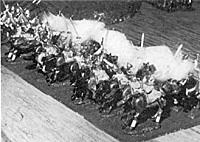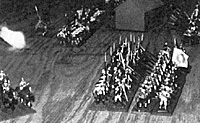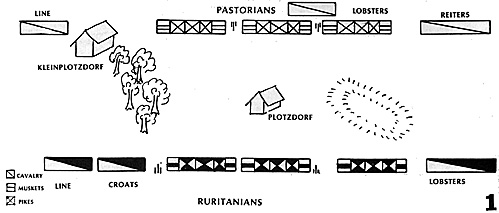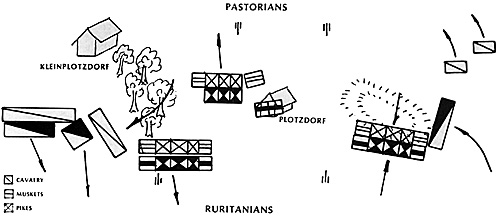 The Pastorian horse catch the Ruritanian regiments maneuvering for a pistol attack and charge home!
The Pastorian horse catch the Ruritanian regiments maneuvering for a pistol attack and charge home!
One of the more attractive little booklets of Pike and Shot rules is Edward B. Protz's Wargamers Guide to the English Civil War. For that reason, and because it was superficially more credible than some of the other sets lying around, I chose this one for a test game while attending a meeting of Potomac Wargamers, (PW) an active Washington D.C. area club.
In comparing ECW rules with basic 30 Years War rules, remember that the ECW occurred in the decade after Gustavus Adolphus brought the shock charge into common use for cavalry, Moreover, while led from the start by many 30 Years War veterans, ECW troops often showed more enthusiasm than discipline at least until the New Model Army began to emerge in East Anglia. Protz favors linear cavalry formations and galloping charges, with a strong chance of unauthorized (uncontrolled) pursuit. Moreover, the concepts of skirmish and evade play little part in his rules.
THE BATTLE OF PLOTZDORF
This one kept me in a constant state of surprise. Not ony did none of us know the rules when we started, but some of the tactics used were novel to say the least.
At the start each force (the Ruritanians and the Pastorians) had one each lobster (extra heavy), heavy, and light cavalry regiments of 12 figures each, three foot regiments each including 12 muskets and 18 pikes; and each side also had two artillery batteries, one heavy, one medium. Both sides deployed in a more or less conventional manner. Infantry in the center, cavalry on the wings. The Ruritanians put their lobsters on the right, Croats and cuirassiers on the left. The Pastorians had reiters on the left, cuirassiers on the right, lobsters in reserve behind the center.
It looked as though the Ruritanians had contrived to win both cavalry melees. However, the wood near Klien Plotzdorf channeled the two Ruritanians on the left. They therefore formed up into one single and one double line and trotted up for a pistol attack. The Pastorian, a shrewd fellow, took advantage of that manuever and charged them on the same turn. With a loss of order due to change in formation, and a slower gait, and only the front ranks fighting, the two Ruritanian units found themselves on the short end of the melee. Their pistol fire, by my reading of the rules, was not improved by their slower gait. Resisting stubbornly, they refused to break until, in the case of the Croats, they were pretty much destroyed (for some reason Croats fight with unexpected determination in these games).
Meanwhile, the infantry masses advanced on one another. Protz prohibits loading and firing while moving at a walk except by extrusion or intrusion (f il ing forward or back in the ranks). Besides, muskets were relatively few (12 figures in 30) so most of the fighting was hand to hand. Even the muskets were more often used butt first than otherwise.
The leftmost Ruritanians, after taking a couple of accidental hits from their own supporting gun, engaged their opponent unit and began losing a long melee. The center unit detached two bases of musketeers to seize Plotzdorf, then flung themselves on the central Pastorian unit at a numerical disadvantage-and began winning. The rightmost unit advanced slowly, and was encouraged by the sight of the Blue Guard thin slicing the unfortunate Pastorian Reiters, -who fired and fought for two turns but didn't do much damage.
Somewhere along about that time, the leftmost Pastorian regiment, instead of going into orbis like sensible folks, walked over the hill and threw itself on the rightmost Ruritanians. The player, whose name escapes me, was muttering things about "taking some of them with me." I found this strange since I could find little provision for casualties on the victorious side.
Curiously, after the Blue Guard had wiped out the left-most musketeers and failed to follow up, that infantry unit did win one melee round. However, I can only regard that as something of an accident
When night fell (Potomac Wargamers session began to fold around midnight) the issue was still in doubt. The Ruritanians were down two cavalry units and one infantry unit. The Pastorians had lost the reiters, but few other horsemen except for 25% of the reserve which ran afoul of a charge of cannister while moving over to mop up the Croats. All Pastorian infantry were still (in the field but two of the units were not going to be there for long. I thought the Pastorians had the edge, but things were pretty close.
As for the rules, they are worthy of study. However, the combination of reduced fire effect factors and the inability of advancing infantry to sustain a firefight make muskets rather superflouous. Since muskets were far from superflouous in the period of play, I see this as a weakness in the rules.
 Infantry comes to push of pike near Plotzdorf. Pastorian lobsters move to support the right flank cavalry.
Infantry comes to push of pike near Plotzdorf. Pastorian lobsters move to support the right flank cavalry.
Another unfortunate quality of the rules is the way they are written. This may be a matter of taste. However, I found it difficult to follow them as we went along, and had to consult Bill Rutherford, who bought the last copy at The Little Soldier, to clarify the provisons for the loser of a melee to inflict casualties against the winner. The rate is apparently 25% of the winner's combat value assessed against the loser, 10% of the loser's against the winner. This is not an unreasonable arrangement, and, except for the weakness of musket fire compared to shock effect (or even pistol fire) and its limit on move- ment as noted above, the rules seem realistic and playable when understood.
I should mention also that the removal of the musket bases facing the Blue Guard, mentioned in the description of the battle, should not have occurred. Protz addresses reductions in the combat value of a unit and, so far as I can tell, does not intend that bases be removed. That would have led to a more realistic result in the case in point.
Once again, I can recommend to anyone interested in this period, especially the ECW, that they get a copy of Protz's rules if they can. The rules are worth the careful study they require, and the historical notes, photos, and diagrams are interesting.


More Renaissance
-
Pike and Shot Part 1: Rules
Pike and Shot Part 1: Battle of Freiburg 1630 (miniature wargame replay)
Pike and Shot Part 2: Battle of Hummelburg 1680 (miniature wargame replay)
Pike and Shot Part 3: Battle of Plotzburg (miniature wargame replay)
Pike and Shot Part 4: WRG Renaissance (rules)
Pike and Shot Part 4: Battle of Hungary 1530 (miniature wargame replay)
Back to Table of Contents -- Courier Vol. III #4
To Courier List of Issues
To MagWeb Master Magazine List
© Copyright 1981 by The Courier Publishing Company.
This article appears in MagWeb (Magazine Web) on the Internet World Wide Web.
Other military history articles and gaming articles are available at http://www.magweb.com